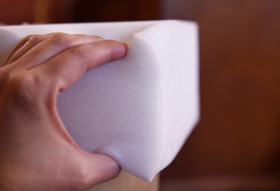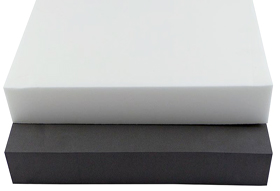
Open vs Closed-cell foams

Given the versatility of foams and the number of uses they have, there is a huge selection of foam types on offer - each of which have their own specific uses, individual material benefits and properties, and a unique composition. One of the most commonly asked questions we receive at eFoam is “What is the difference between open and closed-cell foam?”. Despite there being a number of foams on offer, knowing the difference between these two properties is a good place to start.
The first difference between the two is fairly obvious – one has an open-cell like structure, whereas the other has a closed-cell bubble like composition. In open-cell foams, the structure is almost free-flowing, and is therefore able to hold pockets of air that ultimately affect the feel and performance of the foam. In contrast, closed-cell foam has pockets that are completely sealed-off from air, and therefore, this foam has a structure that feels more solid.

Given their varied composition, the feel of these two foams is different. Open-cell foams typically feel a lot softer, less firm and are very springy, whereas closed-cell foams are firmer and more rigid and tend to have less spring. Yet when choosing between an open-cell and closed-cell foam, it’s worth noting that not all ‘cells’ within an open-cell foam component need to be ‘open’ in order to be classified as such. If a foam has a mixed open and closed cell structure, it will be termed open-cell, yet will be a little firmer than its wholly open counterpart.
Despite the differences in structure, both foams are as durable as each other, and naturally, are of the same high quality when ordered from eFoam. One common misconception between the two foam types is that the differences in structure equate to the thickness or density of the foam, and this is not the case. Their composition does, however, influence where each foam type is best used. For example, open-cell foams are fantastic for furniture and mattresses where comfort is key. The possibilities are endless, as open-cell foams are commonly used for upholstery applications such as sofas, cushions, car seats, support items, and more. That said, it is also available in a range of densities to suit various comfort levels, and can either be incredibly soft or very firm and dense.

On the other end of the spectrum is closed-cell foam, which is popular in furnishings and other uses where firmness and resistance to the elements is key. For example, as the popularity of outdoor furniture continues to grow, closed-cell foam is the perfect seating filler as it is resistant to water due to its closed composition. Likewise, the rigidity of closed-cell foams mean that it is the perfect option in packaging solutions that require security and protection. It’s composition also makes it a fantastic insulator, and it is not uncommon to see closed-cell foams used as building insulation, as well as in other electric and heating components that require both protection and lining.
Both closed-cell and open-cell foams are incredibly durable, although the choice you make ultimately depends on the intended application. Closed-cell is typically tougher against rips and tears, but open-cell offers an unparalleled softness.
If you require any guidance on choosing between an open or closed-cell foam, please contact our friendly advisers.

